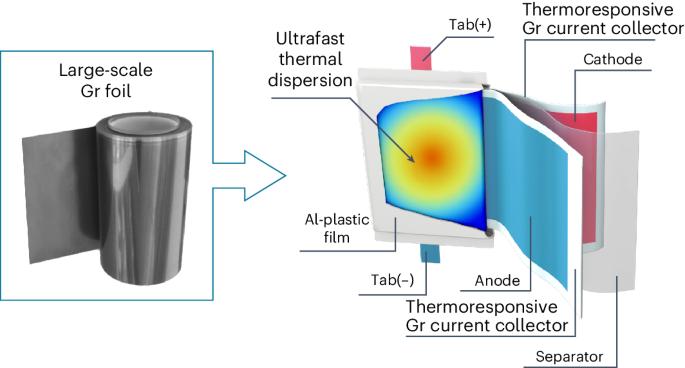Large-scale current collectors for regulating heat transfer and enhancing battery safety
引用次数: 0
Abstract
Thermal runaway, a major battery safety issue, is triggered when the local temperature exceeds a threshold value resulting from slower heat dissipation relative to heat generation inside the cell. However, improving internal heat transfer is challenged by the low thermal conductivity of metal current collectors (CCs) and challenges in manufacturing nonmetal CC foils at large scales. Here we report a rapid temperature-responsive nonmetallic CC that can substitute benchmark Al and Cu foils to enhance battery safety. The nonmetallic CC was fabricated through a continuous thermal pressing process to afford a highly oriented Gr foil on a hundred-meter scale. This Gr foil demonstrates a high thermal conductivity of 1,400.8 W m−1 K−1, about one order of magnitude higher than those of Al and Cu foils. Importantly, LiNi0.8Co0.1Mn0.1O2||graphite cells integrated with these temperature-responsive foils show faster heat dissipation, eliminating the local heat concentration and circumventing the fast exothermic aluminothermic and hydrogen-evolution reactions, which are critical factors causing the thermal failure propagation of lithium-ion battery packs. Understanding and preventing thermal runaway is critical to ensuring the safe and reliable operation of batteries. Here the authors demonstrate the large-scale production of a highly conductive graphene-based foil current collector to mitigate thermal runaway in high-capacity batteries.

用于调节传热和提高电池安全性的大规模电流收集器
热失控是电池安全的一个主要问题,当局部温度超过阈值时,电池内部的散热速度相对于发热速度较慢,从而引发热失控。然而,由于金属集流体(CC)的热传导率较低,以及大规模制造非金属集流体箔的挑战,改善内部热传导面临挑战。在此,我们报告了一种快速温度响应非金属 CC,它可以替代基准铝箔和铜箔,从而提高电池的安全性。这种非金属 CC 是通过连续热压工艺制造的,从而获得了百米级的高取向性 Gr 箔。这种 Gr 箔的热导率高达 1,400.8 W m-1 K-1,比铝箔和铜箔高出约一个数量级。重要的是,集成了这种温度响应箔的 LiNi0.8Co0.1Mn0.1O2|| 石墨电池的散热速度更快,消除了局部热量集中,避免了快速放热的铝热反应和氢化反应,而这些反应是导致锂离子电池组热失效传播的关键因素。了解和防止热失控对于确保电池的安全可靠运行至关重要。作者在本文中展示了大规模生产基于石墨烯的高导电箔电流收集器,以缓解大容量电池中的热失控现象。
本文章由计算机程序翻译,如有差异,请以英文原文为准。
求助全文
约1分钟内获得全文
求助全文

 求助内容:
求助内容: 应助结果提醒方式:
应助结果提醒方式:


